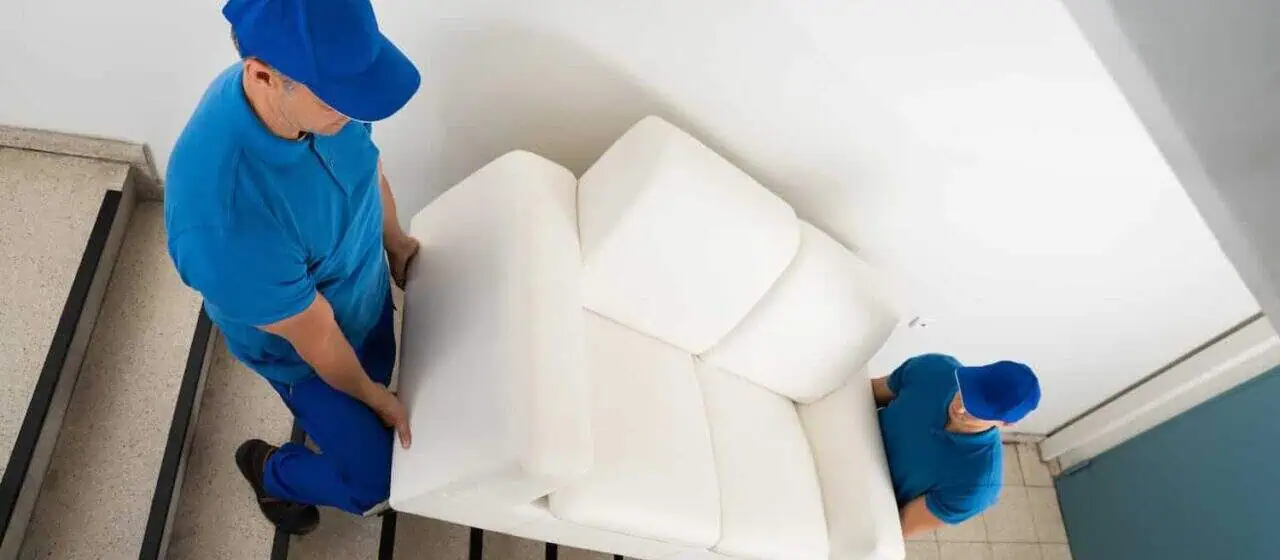How To Move Heavy Furniture Down Stairs
Posted in: Mover Stories, Moving StoriesTechnique. Finesse. And a bit of muscle. That’s what movers use to get heavy, bulky pieces of furniture safely down flights of stairs. To get your own sofa or dresser down your staircase without damaging your home or your health, that’s what you’ll need, too.
So grab hold of the following tips for maneuvering big bulky things down seemingly tight staircases, and turn your own situation into a safe and successful move.
Five Tips to Make Moving Heavy Things Down the Stairs Easier
- Lighten up: Take out drawers, remove shelves, and disassemble any furniture you can into manageable pieces.
- Clear the way: Get rid of rugs under your feet, light fixtures overhead, and anything else you might knock into or trip over.
- Get a grip: Furniture pads protect, but they also can be slippery. Cover them in shrink wrap to create stickier surfaces for your hands.
- Slide down: A piece of furniture with a flat side can be slid right down the steps. But use furniture pads as a cushion!
- Watch the legs: Never pick up any piece of furniture by its legs if they’re long and skinny. They will break right off in your hands. Also, watch out for fragile decorative bits on tops of items like armoires, hutches, and curios.
How to Use a Hand Truck Going Down Stairs
You might wonder if it’s possible — or safe — to use a hand truck (sometimes called a dolly) to get that dresser or sofa down the stairs.
It is possible! Assuming the stairs are wide enough and straight. Otherwise, you’ll get stuck maneuvering a sofa and hand truck around a corner. Whether it is safe to wheel a sofa down a staircase largely depends on you and your hand truck. Here are six steps to make the job both safer and easier.
Step 1: Find a hand truck big enough for the job
The size of the bottom plate is not usually a concern. The back (upright) part is what needs to be long enough for you to reach the handles — and hold on! — once you get that sofa or dresser loaded onto it. Even if you can manage to keep hold of the handles, if your hand truck is too short, you might end up knocking your face into the furniture on the way down.
Step 2: Avoid scratching your stuff
Whatever you are carrying will bounce and shift around on that hand truck with each step. Use blankets or furniture pads to cover the upright part of the truck so no metal parts are exposed. Taping the blankets or pads to the uprights will not only keep them in place but also adds a measure of non-slip to the set-up.
See prices for local moving labor. Read real customer reviews. Easily book your help online.
Step 3: Strap in your furniture
The heavier the item you’re carrying, the more it will bounce and shift down each step. A way to get around this is to tie it down firmly. Some trucks come with a built-in strap. Others don’t, in which case you’ll want to improvise, with a strap from your rental truck (if there are any) or some stout rope tied firmly.
Step 4: Opt for a hand truck with sliders on the back
Sliders are handle-like attachments located on the back of the hand truck, down near the bottom of the uprights next to the wheels. Sometimes made of plastic, they are optimally covered in thick, soft carpet-like material, which adds a cushion that creates a smooth, safe transition from step to step when the wheels are off the floor.
Step 5: Get some help

Step 6: Take it one stair at a time
With a firm grip on the handles and the truck facing straight, ease down the first step. Communicate clearly with your assistant down below. After each step, bring your truck to a complete stop. Make any necessary adjustments (grip, direction, angle, etc.) before tackling the next step.
Note that actually going down the stairs is the last step in the process. Safety and success come from being properly prepared, with the right equipment and enough hands for the job.
What is a Stair Roller?
In the evolution of moving equipment, the term “stair roller” has come to refer to a few different things.
The earliest one I encountered in my moving career consisted of simple conveyor belt mechanisms that attached to a hand truck, down near the bottom of the uprights. Since the slip-resistant rubber treads would, in a sense, crawl forward instead of sliding over the edge of each step, the risk of scratching the stairs would be minimal.
“In some instances, gloves are your best friend in maintaining a good grip on things. Without gloves, a hot day will have your bare and sweaty hands slipping and sliding off the furniture you’re carrying.”
Then there’s this six-wheeled contraption that is designed for stairs with a standard drop. On stairs with a larger drop, this type of hand truck will have to be lowered with muscle power until the wheels reach the step below.
Also out there are these cousins to the rolling pin. Compact and ostensibly easy to use, they are completely detached from whatever is being moved, so you have to use your bare hands to keep the furniture from rolling out of control down the stairs. At least three people are needed: two to support the item being moved and one to move the rollers from behind the item to the front as the crew makes its way down the stairs. I wouldn’t suggest this option.
There are also next-generation motorized trucks, which are as impressively priced as you might expect.
How to Move Furniture Down the Stairs by Hand
Moving big furniture pieces, like moving most things, isn’t rocket science. But when it comes to getting heavy items down flights of stairs (safely!), every tip and trick is welcome.
Here are the steps to get a couch down the stairs without the help of equipment.
Step 1: Measure your staircase
For a straight flight of stairs, you’ll simply need to know how wide it is. If you have an angled staircase you’ll want to measure the height of the staircase as well, meaning from the corner steps to the ceiling. Also, take into account any handrails and banisters protruding from the walls.
Step 2: Measure the height and depth of your furniture
Since you already know how wide your staircase is, you’ll know right away if you can carry your couch, dresser, or other piece upright or if you’ll need to carry it on its back. If it is too wide either way, you may need to carry it at a forty-five-degree angle. If your staircase is angled, measure your furniture’s length. You’ll need to stand it on end around the corner of the staircase, so make sure it isn’t longer than the staircase’s ceiling is high.
Step 3: Make your furniture manageable
For couches, remove any unattached cushions. For a sofa bed, take out the mattress. Anything to make it lighter. If the space is going to be tight, remove the legs if possible. You can usually simply unscrew them from the frame by turning them.
For dressers, armoires, and similar, remove all of the drawers and secure any doors. If the legs come off these pieces, remove those too.
Pro tip: Shrink wrap compresses couch cushions and pillowy armrests, perhaps giving you the extra inches you need while also making the couch easier to grasp. But never use shrink wrap on leather!
Step 4: Get a grip
If your furniture has short, stout legs, they might offer the best handholds. If you need them for this reason, it might be worth it to keep them attached. This is especially pertinent for the person at the high end of the item going down the stairs. Unlike the person at the bottom, who will be pushing against gravity, the person above will need to have a firm hold on his end to keep the piece of furniture from falling downward onto the person below.
In some instances, gloves are your best friend in maintaining a good grip on things. Without gloves, a hot day will have your bare and sweaty hands slipping and sliding off the furniture you’re carrying. And watch your knuckles as you go down! Slamming them into a doorjamb or scraping them against the wall can hurt enough to make you drop your couch.
Step 5: Taller person below, shorter person above
As you begin descending the staircase, your furniture will angle downward, more or less parallel to the stairs, but the person on the bottom will be a step or two below the lower end of the item, meaning that end will be up around their chest.
Meanwhile, the person above will be a step or two higher than the top end of the piece of furniture, which will be somewhere around their knees. Alleviate the situation by having the taller person below.
See prices for local moving labor. Read real customer reviews. Easily book your help online.
Step 6: One step at a time
This is the key to safety any time you are navigating stairs. Pause after each step to make sure everything is balanced and to give yourself a chance to glance down at the next step your feet will need to find.
For an angled staircase, you’ll need to stand the furniture on end, and coax it around the corner and down each step. If you’re moving a couch, this means you’ll want to carry it with the backside down, and for dressers/armoires, you want the legs facing forward. This is so when you stand it on end and slide it off the edge of each corner step, the legs won’t be bearing the entire weight of the piece.
Pro tip: Place a furniture pad on the first corner step and set the end of the furniture on top. This will protect it while offering the ability to slide it toward the edge of each corner step without scraping or scratching the floor.
What If My Couch Doesn’t Fit Down the Stairs?
Well, it evidently made it up so it should make it back down. But if your couch won’t fit down your straight staircase either upright or on its back, try turning it forty-five degrees forward. This means:
- The front bottom edge of the couch is pointed toward the floor
- The back bottom edge is facing one wall
- The open seat cushion side facing the other wall
Your couch will be at its narrowest at this angle, so hopefully, that will help you maneuver it down.
The same general idea applies to an angled staircase. But to make your couch fit around the corner, you’ll have to stand it on end with the seat side facing the inside corner so you can wrap it around. Plan ahead and make sure you have the seat side of your couch facing the right way before you start going down!
How Do You Move a Couch Down the Stairs by Yourself?
You don’t. You don’t want to anyway, although it’s not impossible. To get a couch from the top of a staircase to the bottom by yourself without damage or serious injury, you’ll need a light couch and plenty of strength and patience.
There are two ways to approach this. If you can’t lift your couch off the ground by yourself, don’t try either of the following. Swallow your pride and get some help.
The first way:
Stand the couch upright on one end and ease it down one step at a time. Lift and set, each step you go down. You might try leaning it slightly backward (meaning toward the top of the stairs) and nudging the bottom end forward and down each successive step, but this requires lots of balance and control.
At all times, you’ll want to be on the step above the couch, not below. You don’t want it falling down on top of you.
The second way:
Lay the couch down on whatever flat surface it may have (maybe the bottom, more likely the back) and slide it down the stairs. I highly recommend wrapping it in furniture pads first!
Understand that although the idea is simple, sliding your couch down the stairs is risky. To handle it from above, you’ll need a super firm grip or some kind of rope or strap tied securely around a sturdy part of the couch. Otherwise, there goes your couch, down the stairs without you.
“Shrink wrap compresses couch cushions and pillowy armrests, perhaps giving you the extra inches you need while also making the couch easier to grasp. But never use shrink wrap on leather!”
If you position yourself below your couch so you can ease it down with more control, make absolutely sure you are able to keep that couch from getting any downward momentum. Otherwise, there goes your couch, down the stairs on top of you.
If you are set on trying to get your couch down the stairs by yourself, consider wrapping it in shrink wrap first. It will help you get a better grip if you’re handling your couch vertically, and it will help keep the couch from slipping out of control if you’re sliding it down the stairs.
But again, moving a couch or anything else bulky and heavy down a flight of stairs by yourself is something I highly discourage. So please, do whatever you can to find an extra pair of hands. It’ll be worth the pizza you’ll be buying as a thank-you.
What if My Furniture Won’t Fit Down the Stairs?
If it went up, theoretically, it should be able to get back down. The obvious exception is furniture that was assembled inside the home. Your options then are to disassemble the piece or try a window – slowly and carefully, secured with rope and/or straps long enough to reach the ground below, with some slack to spare.
If none of these is an option, it’s your call. Leave it behind (with the blessing of your landlord or buyer), or cut it into pieces and dispose of it properly.
Final Words on the Best Way to Move Heavy Furniture Down Stairs
At a glance, it may seem impossible to get your sofa, your dresser, or anything else that big down those stairs. But as the old saying goes, what can go up can come down. Okay, that’s not exactly the saying, but you get the idea.
Remember, the point is not simply to get that piece of furniture down the steps but to do it safely, without damaging your furniture, your home, or yourself.
With the right technique and enough muscle, you can do it just like the pros
If you’re not convinced, or you’re simply not confident, no problem. You can hire professional movers who will help you move your furniture down the stairs or down the block.









